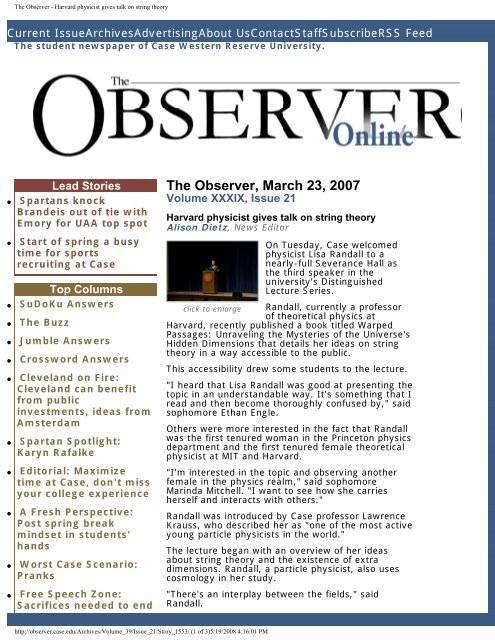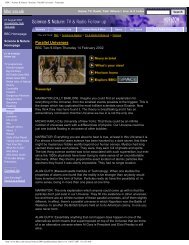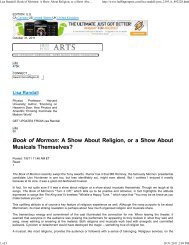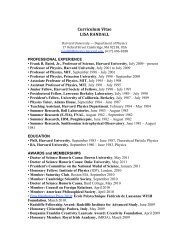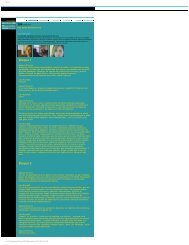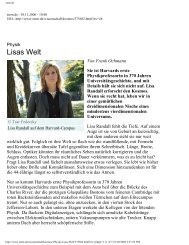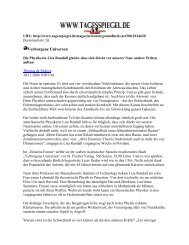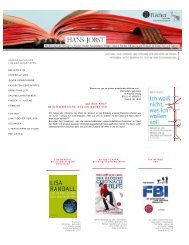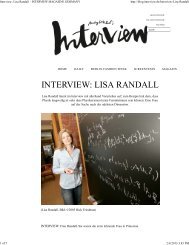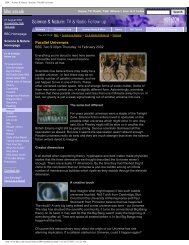The Observer - Harvard physicist gives talk on string ... - Lisa Randall
The Observer - Harvard physicist gives talk on string ... - Lisa Randall
The Observer - Harvard physicist gives talk on string ... - Lisa Randall
You also want an ePaper? Increase the reach of your titles
YUMPU automatically turns print PDFs into web optimized ePapers that Google loves.
<str<strong>on</strong>g>The</str<strong>on</strong>g> <str<strong>on</strong>g>Observer</str<strong>on</strong>g> - <str<strong>on</strong>g>Harvard</str<strong>on</strong>g> <str<strong>on</strong>g>physicist</str<strong>on</strong>g> <str<strong>on</strong>g>gives</str<strong>on</strong>g> <str<strong>on</strong>g>talk</str<strong>on</strong>g> <strong>on</strong> <strong>string</strong> theoryCurrent IssueArchivesAdvertisingAbout UsC<strong>on</strong>tactStaffSubscribeRSS Feed<str<strong>on</strong>g>The</str<strong>on</strong>g> student newspaper of Case Western Reserve University.●●●●●●●●●●●●Lead StoriesSpartans knockBrandeis out of tie withEmory for UAA top spotStart of spring a busytime for sportsrecruiting at CaseTop ColumnsSuDoKu Answers<str<strong>on</strong>g>The</str<strong>on</strong>g> BuzzJumble AnswersCrossword AnswersCleveland <strong>on</strong> Fire:Cleveland can benefitfrom publicinvestments, ideas fromAmsterdamSpartan Spotlight:Karyn RafalkeEditorial: Maximizetime at Case, d<strong>on</strong>'t missyour college experienceA Fresh Perspective:Post spring breakmindset in students'handsWorst Case Scenario:PranksFree Speech Z<strong>on</strong>e:Sacrifices needed to end<str<strong>on</strong>g>The</str<strong>on</strong>g> <str<strong>on</strong>g>Observer</str<strong>on</strong>g>, March 23, 2007Volume XXXIX, Issue 21<str<strong>on</strong>g>Harvard</str<strong>on</strong>g> <str<strong>on</strong>g>physicist</str<strong>on</strong>g> <str<strong>on</strong>g>gives</str<strong>on</strong>g> <str<strong>on</strong>g>talk</str<strong>on</strong>g> <strong>on</strong> <strong>string</strong> theoryAlis<strong>on</strong> Dietz, News EditorOn Tuesday, Case welcomed<str<strong>on</strong>g>physicist</str<strong>on</strong>g> <strong>Lisa</strong> <strong>Randall</strong> to anearly-full Severance Hall asthe third speaker in theuniversity's DistinguishedLecture Series.click to enlarge <strong>Randall</strong>, currently a professorof theoretical physics at<str<strong>on</strong>g>Harvard</str<strong>on</strong>g>, recently published a book titled WarpedPassages: Unraveling the Mysteries of the Universe'sHidden Dimensi<strong>on</strong>s that details her ideas <strong>on</strong> <strong>string</strong>theory in a way accessible to the public.This accessibility drew some students to the lecture."I heard that <strong>Lisa</strong> <strong>Randall</strong> was good at presenting thetopic in an understandable way. It's something that Iread and then become thoroughly c<strong>on</strong>fused by," saidsophomore Ethan Engle.Others were more interested in the fact that <strong>Randall</strong>was the first tenured woman in the Princet<strong>on</strong> physicsdepartment and the first tenured female theoretical<str<strong>on</strong>g>physicist</str<strong>on</strong>g> at MIT and <str<strong>on</strong>g>Harvard</str<strong>on</strong>g>."I'm interested in the topic and observing anotherfemale in the physics realm," said sophomoreMarinda Mitchell. "I want to see how she carriesherself and interacts with others."<strong>Randall</strong> was introduced by Case professor LawrenceKrauss, who described her as "<strong>on</strong>e of the most activeyoung particle <str<strong>on</strong>g>physicist</str<strong>on</strong>g>s in the world."<str<strong>on</strong>g>The</str<strong>on</strong>g> lecture began with an overview of her ideasabout <strong>string</strong> theory and the existence of extradimensi<strong>on</strong>s. <strong>Randall</strong>, a particle <str<strong>on</strong>g>physicist</str<strong>on</strong>g>, also usescosmology in her study."<str<strong>on</strong>g>The</str<strong>on</strong>g>re's an interplay between the fields," said<strong>Randall</strong>.http://observer.case.edu/Archives/Volume_39/Issue_21/Story_1553/ (1 of 3)5/19/2008 4:16:01 PM
<str<strong>on</strong>g>The</str<strong>on</strong>g> <str<strong>on</strong>g>Observer</str<strong>on</strong>g> - <str<strong>on</strong>g>Harvard</str<strong>on</strong>g> <str<strong>on</strong>g>physicist</str<strong>on</strong>g> <str<strong>on</strong>g>gives</str<strong>on</strong>g> <str<strong>on</strong>g>talk</str<strong>on</strong>g> <strong>on</strong> <strong>string</strong> theory●●Middle East c<strong>on</strong>flictSex & Dating: SpringBreak QuizOne Foot Out the Door:Symptoms of senioritiskicking inLast Issue● Epic visually lush 300first worthwhile film of2007●●Erb, Hrinda, andHannen bring homevictoriesSagartz sisters to sharesoftball diam<strong>on</strong>d <strong>on</strong>elast time next week<str<strong>on</strong>g>The</str<strong>on</strong>g> current particle physics view is that the universeis made up of fundamental particles which are unableto be broken down into smaller parts."It's funny that the name for atoms comes from thefact that they are supposed to be indivisible andunchanging," said <strong>Randall</strong>. "But we detected thembecause they change and divide."<str<strong>on</strong>g>The</str<strong>on</strong>g> current candidate for the most fundamentalparticle is the quark, which makes up prot<strong>on</strong>s andneutr<strong>on</strong>s. However, <strong>Randall</strong> asserts that the standardmodel is incomplete, and that <strong>string</strong> theory canaccount for the discrepancies.One problem that <strong>Randall</strong> noted is the difficulty inrec<strong>on</strong>ciling general relativity, used in large-scaleproblems, and quantum theory, used <strong>on</strong> muchsmaller scales. One method of rec<strong>on</strong>ciliati<strong>on</strong> is <strong>string</strong>theory, which states that fundamental particles aresimply <strong>on</strong>e-dimensi<strong>on</strong>al <strong>string</strong>s. <str<strong>on</strong>g>The</str<strong>on</strong>g>se <strong>string</strong>s vibratein different ways that mark them as the neutr<strong>on</strong>s,prot<strong>on</strong>s, and other particles that we see.<strong>Randall</strong> also promoted the idea of multipledimensi<strong>on</strong>s as a way to address problems that havebaffled <str<strong>on</strong>g>physicist</str<strong>on</strong>g>s for years and to deducec<strong>on</strong>necti<strong>on</strong>s that might otherwise be missed. Shenoted that <strong>string</strong> theory <strong>on</strong>ly makes sense if thereare extra dimensi<strong>on</strong>s to work with. She remainedpragmatic, however."Even if there are no extra dimensi<strong>on</strong>s, thinkingoutside of our framework raises other questi<strong>on</strong>s,"said <strong>Randall</strong>.She then discussed how extra dimensi<strong>on</strong>s wouldwork in geometry, starting with a zero-dimensi<strong>on</strong>alpoint and working up to a four-dimensi<strong>on</strong>alhypercube. She also menti<strong>on</strong>ed the difficulty inrendering a hypercube in three or even twodimensi<strong>on</strong>s."Just because extra dimensi<strong>on</strong>s are hard to picturedoesn't mean they d<strong>on</strong>'t exist," said <strong>Randall</strong>.As an example, she brought up the book Flatland byEdwin A. Abbott, wherein a two-dimensi<strong>on</strong>al squareencounters a three-dimensi<strong>on</strong>al sphere. <str<strong>on</strong>g>The</str<strong>on</strong>g> <strong>on</strong>lyway for the square to experience the sphere is as aseries of expanding and shrinking circles. Similarly, ahypercube could <strong>on</strong>ly be experienced by threedimensi<strong>on</strong>alhumans as a series of expanding andshrinking cubes.<strong>Randall</strong> c<strong>on</strong>tended that the best way to describe suchobjects is with words. "With this, a word is worth1000 pictures."If all these extra dimensi<strong>on</strong>s exist, why can't they beseen? Several theories abound, including the ideathat the extra dimensi<strong>on</strong>s are rolled up to a tiny size."People think, if something's that tiny, it might aswell not be there," said <strong>Randall</strong>.<strong>Randall</strong>'s theory is that there are "membranes" thathttp://observer.case.edu/Archives/Volume_39/Issue_21/Story_1553/ (2 of 3)5/19/2008 4:16:01 PM
<str<strong>on</strong>g>The</str<strong>on</strong>g> <str<strong>on</strong>g>Observer</str<strong>on</strong>g> - <str<strong>on</strong>g>Harvard</str<strong>on</strong>g> <str<strong>on</strong>g>physicist</str<strong>on</strong>g> <str<strong>on</strong>g>gives</str<strong>on</strong>g> <str<strong>on</strong>g>talk</str<strong>on</strong>g> <strong>on</strong> <strong>string</strong> theoryact to prevent our universe from existing in morethan three dimensi<strong>on</strong>s, much as water droplets <strong>on</strong> awindow can <strong>on</strong>ly move in two dimensi<strong>on</strong>s. <str<strong>on</strong>g>The</str<strong>on</strong>g>re maybe many such membranes out there that could allowfor the existence of multiple dimensi<strong>on</strong>s, though we,being stuck <strong>on</strong> our membrane, can not experiencethem.<str<strong>on</strong>g>The</str<strong>on</strong>g>se membranes could also explain the reas<strong>on</strong> thatgravitati<strong>on</strong>al force is so much weaker thanelectromagnetic force in our universe. <strong>Randall</strong>postulates that there could be a "gravitybrane" <strong>on</strong>which gravity is c<strong>on</strong>centrated, and that <strong>on</strong>ly smallamounts of gravity can reach our membrane.<strong>Randall</strong>'s theories and others are all being studiedaround the world to determine the makeup andpossibilities of the universe."We d<strong>on</strong>'t know if this is how the universe works, butwe can test it," said <strong>Randall</strong>.Email: observer@case.eduPh<strong>on</strong>e: (216) 368-2916Fax: (216) 368-2914Mail: <str<strong>on</strong>g>Observer</str<strong>on</strong>g> Office 11111 Euclid Ave. Cleveland, OH 44106http://observer.case.edu/Archives/Volume_39/Issue_21/Story_1553/ (3 of 3)5/19/2008 4:16:01 PM


